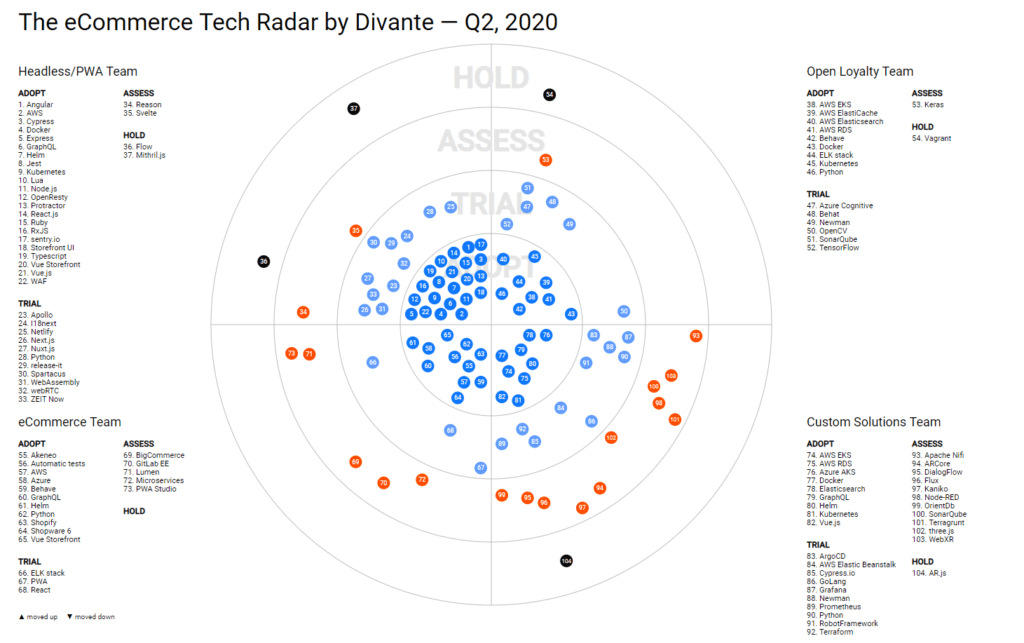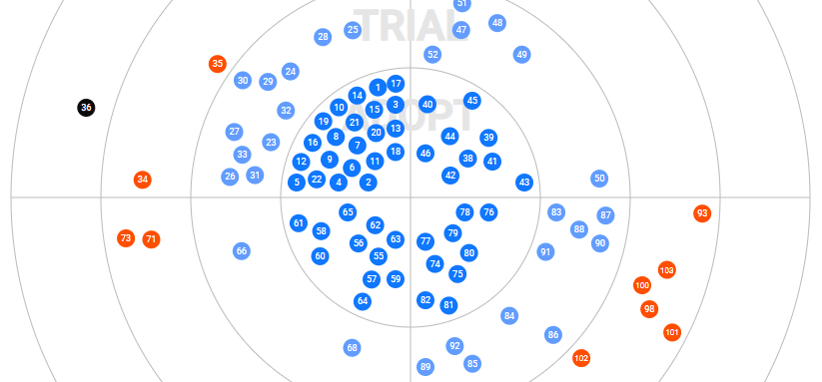How to pick the right technologies for your online store? Sometimes such a choice is a matter of survival for an eCommerce business. That’s why, together with the architects at Divante, I’ve analyzed a bunch of popular in eCommerce platform solutions and set them on our radar of technologies.
What is Tech Radar for eCommerce?
The eCommerce Tech Radar is a tool to inspire and support your team to pick the best technologies for new projects. The format, inspired by the original Thought Works Technology Radar, has been selected democratically by our architects.
The radar is maintained by all of our technical teams that are ranged from experts in eCommerce platforms, headless solutions, loyalty applications, custom software development, and other solutions for eCommerce. It is an important tool of our work and we keep it up to date.
Click here to open Divante’s eCommerce Technology Radar (last update: IV, 2020)
How to work with eCommerce Tech Radar? Discover the ring assignment.
One of the most important features of the report is the ring assignment. We asked each of the teams to assign their findings into the following categories (rings):
- ADOPT — Technologies we have high confidence in serving our purpose, also on a large scale. Technologies with a usage culture in our production environment, low risk and recommended as being widely used.
- TRIAL — Technologies that we have seen work with success in project work to solve a real problem; first serious usage experience that confirms benefits and can uncover limitations. TRIAL technologies are slightly riskier; some engineers in our organization have walked this path and will share knowledge and experiences.
- ASSESS — Technologies that are promising and have clear potential value-add for us; technologies worth investing some research and prototyping efforts in to see if it has an impact. ASSESS technologies have higher risks; they are often brand new and highly unproven in our organization. You will find some engineers that have knowledge in the technology and promote it, you may even find teams that have started a prototyping effort.
- HOLD — Technologies not recommended to be used for new projects. Technologies that we think are not (yet) worth (further) investment. HOLD technologies should not be used for new projects but can usually be continued for existing projects.
The Radar idea itself isn’t very unique. Different companies have already adopted their insights using this format, such as Zalando or Wayfair. What’s really interesting, however, is to benchmark how different companies approach pretty much similar challenges.
“We first thought about categorizing the technologies in a common schema, as Zalando did, by dividing the technologies into functional categories: Frameworks, Infrastructure, Data Management. But then we thought that our unique feature is that Divante combines different teams and works on different challenges, so we can benchmark the technologies between the tribes themselves and learn new technologies just by that.”
Cezary Olejarczyk, CTO of Open Loyalty, who introduced the Tech Radar idea to Divante

Click to see interactive eCommerce Tech Radar.
It’s pretty interesting to discover the intersections between the different teams. Even though they’re on different leading stacks, varying from JavaScript to PHP, there is some visible commonality in technology adoption trends.
The most important conclusions from the eCommerce Tech Radar:
Cloud is the new base for stack
Amazon Web Services were marked as ADOPT by 3 out of 4 Divante tribes. Different services ranging from EKS and ElasticCache (Open Loyalty, Headless team) to EC2 and Container services (by eCommerce team).
Most of them are based on open-source products. The cloud gives them the horizontal scalability making these services just work and provide the business value, lowering the TCO (total cost of ownership).
For the internal infrastructure and client’s private clouds, Kubernetes is becoming a new industry standard. Our teams combine it with Helm for the complex installation management. The whole Storefront Cloud and Open Loyalty Cloud have been built using this stack.
“The paradigm has shifted and most CTOs are now keen to invest in business value rather than just maintaining the whole stack and keeping it up and running.”
Piotr Karwatka, CTO of Divante
Solutions as a Service are in the core
Services are getting from more general Super Cloud Providers, as well as more specialized applications like Shopware 6 and Shopify. The customizations and new features—which are our bread and butter—are built as separate micro-applications around the Core System.
“Feature phones were replaced long ago by smartphones—platforms for app developers, rather than all-inclusive toys you can hardly customize to your needs. We see a pretty similar approach in the enterprise software development area.”
Piotr Karwatka
The new architecture should be aligned with the team structures
“Any organization that designs a system (defined broadly) will produce a design whose structure is a copy of the organization’s communication structure.”
Melvin E. Conway
The Service-Oriented Architecture is not leading just to technology choices but re-organizes the team structures as well. Microservices were marked as Assess or Adopt by most of our team, despite the technology they’re based on.
We’re moving towards Behavioral Driven Development
Technology is, in the end, always somehow related to the human behaviors and collaboration principles. From the current Radar, seemingly most of our teams are adapting some form of Behavioral Driven Development (BDD). Communication is a key in this process and we’ll try to shed some light on how this “Behave” collaboration pattern is being implemented at Divante.
What’s next on the eCommerce Tech Radar?
We plan to publish the subsequent posts in a form of interviews with Divante’s architects. They will present in more detail the most interesting technologies and their use-cases in real projects. Look out for more!
Are you looking for more resources on microservices and headless solutions? Here are two of my books that will guide your through the most significant changes in the technologies in eCommerce:
Published April 23, 2020












